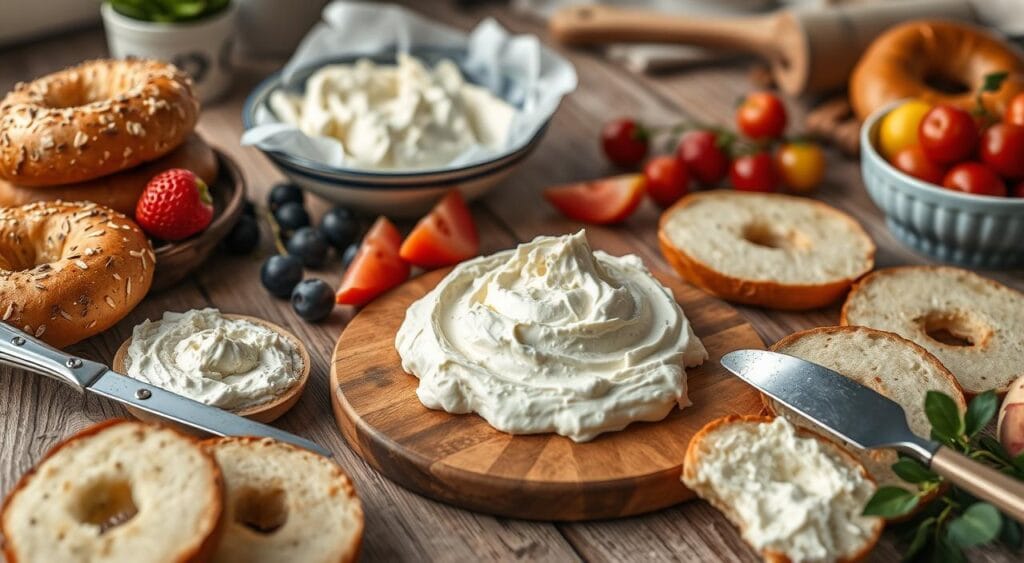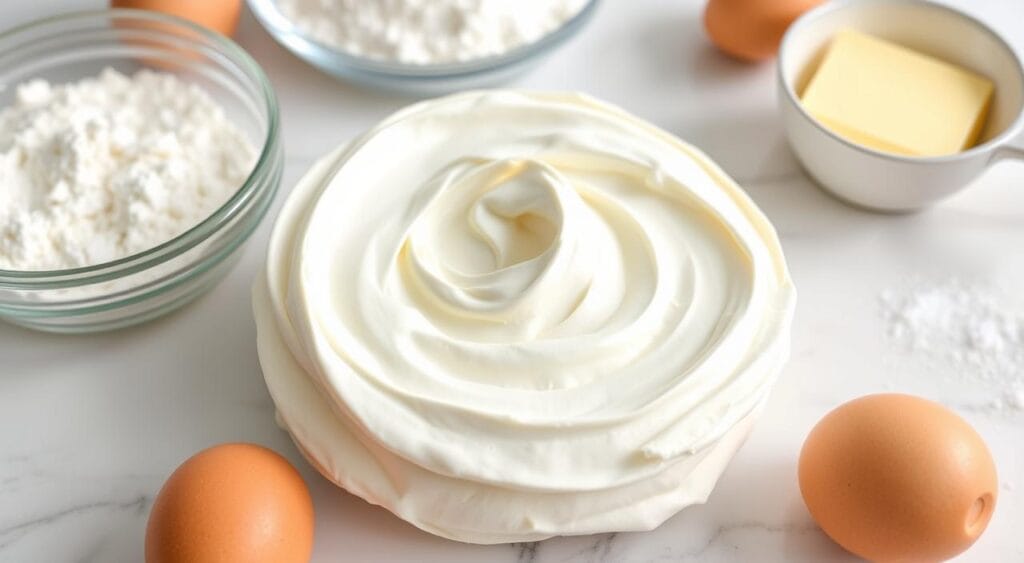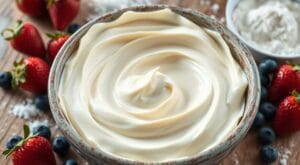Jump to:
Philadelphia cream cheese is a staple in many kitchens. It’s not just for bagels and sandwiches. It can also change the game in cooking. Yes, you can use Philadelphia for baking, making both savory and sweet dishes amazing.
This guide will show you how to use Philadelphia cream cheese in cooking. It’s a great choice for many dishes. We’ll also answer some common questions.
Key Takeaways
- Philadelphia cream cheese can be used in a variety of baked goods, from cheesecakes to muffins and frostings.
- The unique creaminess and texture of Philadelphia make it a versatile ingredient for both sweet and savory recipes.
- Philadelphia is often preferred over other cream cheeses for its smooth, consistent quality and flavor.
- Proper techniques like softening the cream cheese and adjusting sugar levels are important for successful baking with Philadelphia.
- Philadelphia cream cheese can be substituted for regular cream cheese, butter, or even yogurt in many recipes.
Introduction
In this guide, we’ll show you how to use Philadelphia cream cheese in cooking. We’ll explain why it’s great for many dishes and answer common questions. It’s perfect for sauces, soups, casseroles, and desserts.
Philadelphia cream cheese is versatile and can make dishes taste better. Its creamy texture and tangy flavor are loved in both sweet and savory recipes. It’s a must-have in every kitchen for adding richness to sauces and making desserts.
We’ll explore the benefits of Philadelphia cream cheese, its best uses in baking and cooking, and share tips for using it. Let’s get started!

“Philadelphia cream cheese is a versatile ingredient that can elevate the flavor and texture of a wide variety of dishes.”
| Ingredient | Amount |
|---|---|
| Graham cracker crumbs | 2 cups, finely crushed |
| Heavy cream | 1 cup, 35% or higher fat content |
| Cream cheese | 2 (8-oz.) blocks, softened |
| Refrigeration time | At least 6 hours or overnight |
| Yield | 12 bars |
The statistics show the ingredients and amounts for a delicious Philadelphia No-Bake Cheesecake. From the crust to the filling, they highlight the role of Philadelphia cream cheese. It’s key for the right texture and flavor.
Why Use Philadelphia for Baking?
Philadelphia cream cheese is a favorite in many baked goods. It’s smooth and creamy, with a mild flavor. This makes it perfect for cheesecakes, muffins, and frostings. It adds creaminess, structure, and a hint of tanginess to your baked items.
Unique Creaminess and Texture
Philadelphia cream cheese is loved for its creamy texture. Its velvety consistency melts well into recipes. This creates a rich, decadent feel without overpowering other flavors.
Versatility in Recipes
Philadelphia cream cheese is versatile in both sweet and savory dishes. Its mild taste balances out sweetness. This makes it great for a wide range of baked goods.
Philadelphia vs. Other Cream Cheeses
Philadelphia cream cheese is unmatched in creaminess and versatility. It has a smoother texture that blends well into recipes. Its flavor is subtle and balanced, making it reliable for both sweet and savory baking.
| Attribute | Philadelphia Cream Cheese | Other Cream Cheeses |
|---|---|---|
| Texture | Smooth, creamy, and spreadable | Can be more grainy or firm |
| Flavor | Mild, well-balanced tang | May have a stronger or more pronounced flavor |
| Versatility | Suitable for both sweet and savory baking | May be better suited for specific applications |

“Philadelphia cream cheese has a signature creaminess that sets it apart from other brands, making it the go-to choice for many home bakers and professionals alike.”
Best Types of Baking with Philadelphia
Philadelphia cream cheese is great for many baked goods. It makes philadelphia cream cheese cheesecakes rich and indulgent. It also makes philadelphia cream cheese muffins and cupcakes tender and moist.
But Philadelphia’s uses don’t stop there. Its philadelphia cream cheese frostings and icings are silky and creamy. And philadelphia cream cheese savory bakes like quiches and tarts offer a tasty twist to traditional recipes.
Cheesecakes
Philadelphia cream cheese is a favorite for cheesecakes. It gives them a smooth, creamy base. Cheesecake recipes often use 3 packages (24 oz) of softened Philadelphia cream cheese.
They also include eggs, sugar, vanilla, and a bit of lemon juice. The batter goes into a pre-baked graham cracker crust. It’s baked at 350°F for 50-75 minutes until set.
After cooling slowly for an hour, it’s chilled for 3-4 hours. This makes the cheesecake perfect for serving.
Muffins and Cupcakes
Philadelphia cream cheese also makes muffins and cupcakes special. It adds a rich, moist texture. Whether swirled in, used in frosting, or mixed into the batter, it makes a big difference.
The high-fat content of Philadelphia prevents dryness. This makes it better than regular cream cheese for these treats.
Frostings and Icings
Philadelphia cream cheese is the best for frostings and icings. It’s smooth and spreadable. It mixes well with powdered sugar, butter, and vanilla for a silky topping.
Its mild flavor lets other tastes like chocolate or fruit stand out. This makes it perfect for cakes and cupcakes.
Savory Bakes: Quiches and Tarts
Philadelphia cream cheese is also great for savory dishes. In quiches and tarts, it adds a creamy richness. Its high-fat content makes the crust tender and flaky.
The mild flavor lets the savory fillings shine. This makes Philadelphia a valuable addition to these dishes.
Tips for Using Philadelphia in Baking
To get the best results with Philadelphia cream cheese in baking, follow some key tips. First, make sure to soften the Philadelphia before using it. This makes the final baked goods smooth and lump-free. Simply leave the cream cheese at room temperature for 30-60 minutes.
When mixing Philadelphia into batters and doughs, mix gently. This avoids a dense or tough texture. Also, be careful not to overbake, as the cream cheese can dry out and become grainy. Check the internal temperature and adjust baking times to prevent this.
How to Soften Philadelphia Properly
- Let Philadelphia cream cheese sit at room temperature for 30-60 minutes before using.
- Avoid microwaving the cream cheese, as it can become overheated and grainy.
- If the cream cheese is still too firm, try breaking it into smaller pieces to help it soften more quickly.
Incorporating Philadelphia into Batters and Doughs
- Gently fold the Philadelphia into the batter or dough, being careful not to overmix.
- If the recipe calls for melted or softened butter or oil, consider using a portion of the Philadelphia to replace some of the fat.
- Adjust the amount of other wet ingredients, such as milk or eggs, to accommodate the additional moisture from the Philadelphia.
Preventing Overbaking with Cream Cheese
| Baked Good | Baking Temperature | Baking Time |
|---|---|---|
| Cheesecake | 350°F | 35-45 minutes |
| Muffins and Cupcakes | 375°F | 18-22 minutes |
| Quiches and Tarts | 375°F | 25-35 minutes |
By following these tips, your baked goods with Philadelphia cream cheese will always be perfect.
Substituting Philadelphia in Recipes
Philadelphia cream cheese is great for replacing traditional cooking cream in many dishes. It has a different texture and taste, but it works well with a few tweaks. To get the right consistency, you might need to add a bit of water, milk, or broth.
Philadelphia is especially good as a substitute for cream in pasta dishes, casseroles, and other savory recipes. It’s also great for baked goods instead of butter or oil. Plus, it can stand in for yogurt or sour cream in both sweet and savory dishes.
For Regular Cream Cheese
Sour cream can be used 1:1 for cream cheese in recipes. Greek yogurt is also a 1:1 substitute. Neufchâtel cheese, with less fat than cream cheese, can be used in the same amount.
For Butter or Oil
Mascarpone, a soft Italian cheese, can replace cream cheese in recipes. Silken tofu, a vegan option, can also be used in equal amounts.
For Yogurt or Sour Cream
Cottage cheese, when blended, can be a cream cheese substitute with heavy cream or half-and-half. Hummus, though different in taste, can be a good substitute due to its texture.
| Substitute | Ratio |
|---|---|
| Sour Cream | 1:1 |
| Greek Yogurt | 1:1 |
| Neufchâtel Cheese | 1:1 |
| Mascarpone | 1:1 |
| Silken Tofu | 1:1 |
| Pureed Cottage Cheese | 1:1 + heavy cream/half-and-half |
| Hummus | Texture substitute |
Common Mistakes to Avoid
When baking with Philadelphia cream cheese, watch out for a few common mistakes. Overmixing, using cold Philadelphia, and not adjusting sugar levels are key issues. These can affect the final result.
Overmixing the Batter
One big mistake is overmixing the batter with Philadelphia cream cheese. This can make the final product dense and tough. To avoid this, mix the Philadelphia gently into the batter until it’s just combined.
Using Cold Philadelphia
Another mistake is using cold Philadelphia cream cheese. It’s hard to mix into the batter when it’s straight from the fridge. Let the Philadelphia come to room temperature before mixing for a smooth blend.
Not Adjusting Sugar Levels
When using Philadelphia instead of other ingredients, adjust the sugar levels. The tang of Philadelphia can change the sweetness of the dish. Taste the batter and adjust the sugar to get the flavor right.
| Common Mistake | Impact | How to Avoid |
|---|---|---|
| Overmixing the Batter | Dense, tough texture | Mix gently until just incorporated |
| Using Cold Philadelphia | Difficulty incorporating | Allow cream cheese to come to room temperature |
| Not Adjusting Sugar Levels | Altered flavor profile | Taste the batter and adjust sugar as needed |
By avoiding these common mistakes, your baked goods with Philadelphia cream cheese will always be perfect.
Storing and Reheating Baked Goods
Storing and reheating baked goods with Philadelphia cream cheese is key. To keep your baked goods with Philadelphia cream cheese fresh and tasty, follow these tips.
Proper Storage Techniques
Keep baked goods with Philadelphia cream cheese in the fridge. Cover them or use an airtight container for up to 4 days. This keeps the cream cheese creamy and prevents it from drying out or getting grainy.
Reheating Tips for Preserving Texture
When reheating baked goods with Philadelphia cream cheese, do it slowly. This prevents the cream cheese from becoming tough or grainy. Use the oven or microwave on low heat to keep the texture smooth and creamy.
Can You Freeze Baked Goods with Philadelphia?
Yes, many baked goods with Philadelphia cream cheese can be frozen for up to 2 months. Wrap them tightly and thaw in the fridge before serving. This keeps the cream cheese’s texture and flavor intact.
By using these storage and reheating tips, you can enjoy your baked goods with Philadelphia cream cheese even after they’re no longer fresh. The trick is to handle the cream cheese gently and keep it at the right temperature. This way, you’ll always get that creamy texture you love.
Conclusion
Philadelphia cream cheese is great for many dishes, from savory to sweet. It has a smooth texture and mild flavor. This makes it perfect for enhancing flavors in your cooking.
Try it in creamy pasta sauces, thickening soups, or baking a cheesecake. Philadelphia cream cheese will make your dish better.
For more ideas, check out Kinsley Recipes. See how Philadelphia cream cheese can improve your cooking. It’s widely available and loved by many for its versatility.
Philadelphia cream cheese has come a long way. It was once a luxury item but now is a staple in kitchens everywhere. It’s a favorite among both home cooks and professional chefs. It’s a great choice to make your dishes stand out and impress your guests.
FAQ
Can you use Philadelphia cream cheese for baking?
Yes, you can use Philadelphia cream cheese for baking. It has a smooth, creamy texture and a mild flavor. This makes it great for both savory and sweet recipes.
What are the benefits of using Philadelphia cream cheese in baking?
Philadelphia cream cheese adds a rich, creamy texture to baked goods. It also enhances their flavor. It’s versatile and works well in both sweet and savory recipes.
How is Philadelphia cream cheese different from other cream cheeses when baking?
Philadelphia cream cheese is known for its smooth texture and mild flavor. This makes it more versatile than other cream cheeses. It can be used in a wider range of recipes without overpowering other flavors.
What types of baked goods can you make with Philadelphia cream cheese?
You can make cheesecakes, muffins, cupcakes, frostings, and icings with Philadelphia cream cheese. It’s also great in savory baked goods like quiches and tarts.
What tips should you follow when baking with Philadelphia cream cheese?
When baking with Philadelphia cream cheese, soften it first. Mix it gently to avoid overmixing. Also, be careful not to overbake to prevent it from becoming dry or grainy.
Can you substitute Philadelphia cream cheese for other ingredients in baking?
Yes, you can substitute Philadelphia cream cheese for regular cream cheese, butter, oil, yogurt, or sour cream in many recipes. Just remember to adjust the sugar levels if needed because of its slight tang.
What are some common mistakes to avoid when baking with Philadelphia cream cheese?
Avoid overmixing the batter, using cold Philadelphia cream cheese, and not adjusting the sugar levels when substituting it for other ingredients.
How should you store and reheat baked goods containing Philadelphia cream cheese?
Store baked goods with Philadelphia cream cheese in the refrigerator, covered or in an airtight container, for up to 4 days. When reheating, do so gently to prevent the cream cheese from becoming tough or grainy. Many can also be frozen for up to 2 months.





